Complete Solutions to SECTION - II of chapter SELF ASSESSMENT PAPER 5 of Class 10 book with complete answers and questions
| Class 10 | BIOLOGY |
| Chapter | SELF ASSESSMENT PAPER 5 |
| OSWAL | SECTION - II |
| Number Of Questions | 76 |
| Academic Year | 2023-24 |
The diagrams given below show the cross-section of two kinds of blood vessels :

Name the parts numbered 1 and 2
View SolutionThe diagrams given below show the cross-section of two kinds of blood vessels :

Name the parts numbered 1 and 2
View SolutionThe diagrams given below show the cross-section of two kinds of blood vessels :
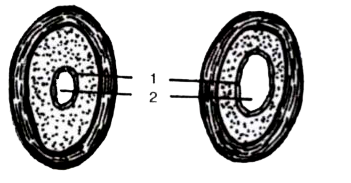
When are the sounds "LUBB" and "DUP produced during a heartbeat?
View SolutionThe diagrams given below show the cross-section of two kinds of blood vessels :
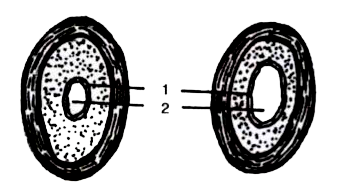
Name the blood vessel that
(1) begins and ends in capillaries
View SolutionClassify the following actions as simple reflex or conditioned reflex :
Playing a guitar.
View SolutionClassify the following actions as simple reflex or conditioned reflex :
Removing your hand suddenly when pricked by a thorn.
View SolutionClassify the following actions as simple reflex or conditioned reflex :
Applying sudden brakes when a dog crosses the path.
View SolutionClassify the following actions as simple reflex or conditioned reflex :
Blinking of eyelids on exposure to light.
View SolutionClassify the following actions as simple reflex or conditioned reflex :
Tying one's shoe lace.
View SolutionStudy the diagram given below and then answer the questions that follow :

State the main function of (1) glucagon, (2) insulin.
View SolutionStudy the diagram given below and then answer the questions that follow :

State the main function of (1) glucagon, (2) insulin.
View SolutionStudy the diagram given below and then answer the questions that follow :

Why is the pancreas referred to as an exoendocrine gland ?
View SolutionStudy the diagram given below and then answer the questions that follow :

Why is insulin not given orally but is injected into the body ?
View SolutionStudy the diagram given below and then answer the questions that follow :
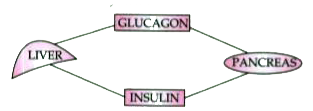
What is the technical term for the cells of the pancreas that produce endocrine hormones ?
View SolutionStudy the diagram given below and then answer the questions that follow :

Where in the body is the pancreas located ?
View SolutionThe diagram given below represents the location and structure of an endocrine gland. Study the same and answer the questions that follow:
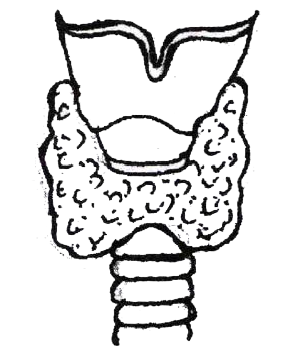
(i) Name the endocrine gland shown in the diagram.
(ii) Name the secretion of the gland which regulates basal metabolism
(iii) Name the mineral element required for the synthesis of the above mentioned hormone.
(iv) Name the disease caused due to undersecretion of the above mentioned hormone in children.
(v) Name the disease caused due to hypersecretion of the above mentioned hormone .
View SolutionThe diagram given below represents the location and structure of an endocrine gland. Study the same and answer the questions that follow:

(i) Name the endocrine gland shown in the diagram.
(ii) Name the secretion of the gland which regulates basal metabolism
(iii) Name the mineral element required for the synthesis of the above mentioned hormone.
(iv) Name the disease caused due to undersecretion of the above mentioned hormone in children.
(v) Name the disease caused due to hypersecretion of the above mentioned hormone .
View SolutionThe diagram given below represents the location and structure of an endocrine gland. Study the same and answer the questions that follow:

(i) Name the endocrine gland shown in the diagram.
(ii) Name the secretion of the gland which regulates basal metabolism
(iii) Name the mineral element required for the synthesis of the above mentioned hormone.
(iv) Name the disease caused due to undersecretion of the above mentioned hormone in children.
(v) Name the disease caused due to hypersecretion of the above mentioned hormone .
View SolutionThe diagram given below represents the location and structure of an endocrine gland. Study the same and answer the questions that follow:

(i) Name the endocrine gland shown in the diagram.
(ii) Name the secretion of the gland which regulates basal metabolism
(iii) Name the mineral element required for the synthesis of the above mentioned hormone.
(iv) Name the disease caused due to undersecretion of the above mentioned hormone in children.
(v) Name the disease caused due to hypersecretion of the above mentioned hormone .
View SolutionThe diagram given below represents the location and structure of an endocrine gland. Study the same and answer the questions that follow:

(i) Name the endocrine gland shown in the diagram.
(ii) Name the secretion of the gland which regulates basal metabolism
(iii) Name the mineral element required for the synthesis of the above mentioned hormone.
(iv) Name the disease caused due to undersecretion of the above mentioned hormone in children.
(v) Name the disease caused due to hypersecretion of the above mentioned hormone .
View SolutionThe diagram given below represents a stage during cell division. Study the same and then answer the questions that follow :

Identify the above stage and give a reason to support your answer.
View SolutionThe diagram given below represents a stage during cell division. Study the same and then answer the questions that follow :
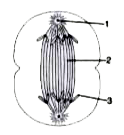
Name the parts labelled 1, 2 and 3.
View SolutionThe diagram given below represents a stage in cell division. Study the same and answer the questions that follows:

What is the unique feature observed in this stage?
View SolutionThe diagram given below represents a stage in cell division. Study the same and answer the questions that follows:
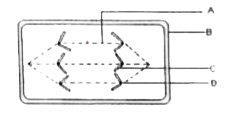
Where does this type of cell division usually occur?
View SolutionThe diagram given below represents a stage in cell division. Study the same and answer the questions that follows:
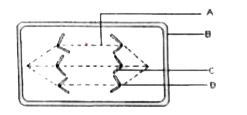
How many daughter cells are formed from this type of cell division ?
View SolutionThe diagram given below represents a stage in cell division. Study the same and answer the questions that follows:
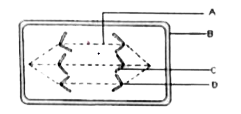
Is the dividing cell shown a plant or an animal cell? Give a reason to support your answer.
View SolutionName the hormone responsible for the following functions
Increase in heartbeat.
View SolutionName the hormone responsible for the following functions:
Maintains glucose level in the blood.
View SolutionName the hormone responsible for the following functions
Converting glycogen to glucose
View SolutionName the hormone responsible for the following functions
Regulates basal metabolism.
View SolutionName the hormone responsible for the following functions
Ossification of bones.
View SolutionName the hormone responsible for the following functions
Prepares the body during emergency.
View SolutionName the hormone responsible for the following functions
Responsible for normal growth of the whole body.
View SolutionName the hormone responsible for the following functions
Regulates the functioning of the male and female reproductive organs.
View SolutionName the hormone responsible for the following functions
Increased reabsorption of water in the kidneys.
View SolutionName the hormone responsible for the following functions
Increased blood supply to muscles.
View SolutionStudy the set-up given alongside and answer the questions given below:

Which physiological process does this setup of experiment show?
View SolutionThe following diagram demonstrates a physiological process taking place in green plants. The whole set up was placed in bright sunlight for several hours. Study the diagram and answer the questions that follow:
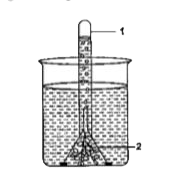
Explain the physiological process mentioned in (i) above.
View SolutionStudy the diagram given below and answer the questions that follow :
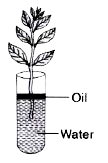
Why is oil placed over water
View SolutionStudy the diagram given below and answer the questions that follow :
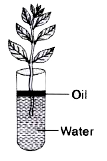
What do we observe with regard to the level of water when this set-up is placed in (1) bright sunlight (2) humid conditions (3) windy day
View SolutionStudy the diagram given below and answer the questions that follow :
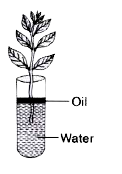
Mention any three adaptations found in plants to overcome the process studied in the experiment. .
View SolutionComplete the following by filling in the blanks numbered 1 to 10 with the appropriate word/ term:
Photosynthesis involves a light reaction and a dark reaction. During the light reaction, the chlorophyll present in the
____________ gets activated by absorbing light energy. This energy splits.
View SolutionComplete the following by filling in the blanks numbered 1 to 10 with the appropriate word/term Photosynthesis involves light reaction and dark reaction. During light reaction, the chlorophyll present in the
(1)…….. gets activated by absorbing light energy This energy splits (2).....molecules to....(3)......and oxygen and releases two electrons. This process is called (4).... The (5).....ions are picked up by NADP to form (6).....The ADP is converted to (7)....This process is called (8).....During the dark phase, the compound produced at the end of light reaction reacts with carbon dioxide to form (9).....This product is converted to starch. The process is called (10) .....
View SolutionComplete the following by filling in the blanks numbered 1 to 10 with the appropriate word/ term:
Photosynthesis involves a light reaction and a dark reaction. During the light reaction, the chlorophyll present in the
____________ gets activated by absorbing light energy. This energy splits.
View SolutionComplete the following by filling in the blanks numbered 1 to 10 with the appropriate word/ term:
Photosynthesis involves a light reaction and a dark reaction. During the light reaction, the chlorophyll present in the
____________ gets activated by absorbing light energy. This energy splits.
View SolutionComplete the following by filling in the blanks numbered 1 to 10 with the appropriate word/ term:
Photosynthesis involves a light reaction and a dark reaction. During the light reaction, the chlorophyll present in the
______ ions are picked up by NADP to form
View SolutionComplete the following by filling in the blanks numbered 1 to 10 with the appropriate word/ term:
Photosynthesis involves a light reaction and a dark reaction. During the light reaction, the chlorophyll present in the
_______ The ADP is converted at the end of the light reaction reacts with carbon dioxide to from
View SolutionComplete the following by filling in the blanks numbered 1 to 10 with the appropriate word/term Photosynthesis involves light reaction and dark reaction. During light reaction, the chlorophyll present in the
(1)…….. gets activated by absorbing light energy This energy splits (2).....molecules to....(3)......and oxygen and releases two electrons. This process is called (4).... The (5).....ions are picked up by NADP to form (6).....The ADP is converted to (7)....This process is called (8).....During the dark phase, the compound produced at the end of light reaction reacts with carbon dioxide to form (9).....This product is converted to starch. The process is called (10) .....
View SolutionComplete the following by filling in the blanks numbered 1 to 10 with the appropriate word/term Photosynthesis involves light reaction and dark reaction. During light reaction, the chlorophyll present in the
(1)…….. gets activated by absorbing light energy This energy splits (2).....molecules to....(3)......and oxygen and releases two electrons. This process is called (4).... The (5).....ions are picked up by NADP to form (6).....The ADP is converted to (7)....This process is called (8).....During the dark phase, the compound produced at the end of light reaction reacts with carbon dioxide to form (9).....This product is converted to starch. The process is called (10) .....
View SolutionComplete the following by filling in the blanks numbered 1 to 10 with the appropriate word/term Photosynthesis involves light reaction and dark reaction. During light reaction, the chlorophyll present in the
(1)…….. gets activated by absorbing light energy This energy splits (2).....molecules to....(3)......and oxygen and releases two electrons. This process is called (4).... The (5).....ions are picked up by NADP to form (6).....The ADP is converted to (7)....This process is called (8).....During the dark phase, the compound produced at the end of light reaction reacts with carbon dioxide to form (9).....This product is converted to starch. The process is called (10) .....
View SolutionComplete the following by filling in the blanks numbered 1 to 10 with the appropriate word/term Photosynthesis involves light reaction and dark reaction. During light reaction, the chlorophyll present in the
(1)…….. gets activated by absorbing light energy This energy splits (2).....molecules to....(3)......and oxygen and releases two electrons. This process is called (4).... The (5).....ions are picked up by NADP to form (6).....The ADP is converted to (7)....This process is called (8).....During the dark phase, the compound produced at the end of light reaction reacts with carbon dioxide to form (9).....This product is converted to starch. The process is called (10) .....
View SolutionThe given diagram represents a nephron and its blood supply. Study the diagram and answer the question :
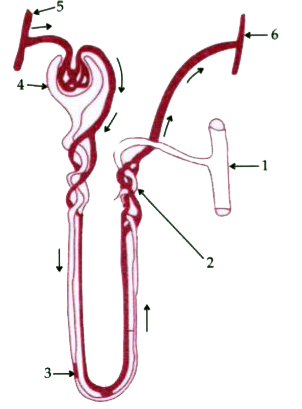
Label parts 1, 2, 3 and 4.
View SolutionThe given diagram represents a nephron and its blood supply. Study the diagram and answer the question :

State the reason for the high hydrostatic pressure in the glomerulus.
View SolutionThe given diagram represents a nephron and its blood supply. Study the diagram and answer the question :
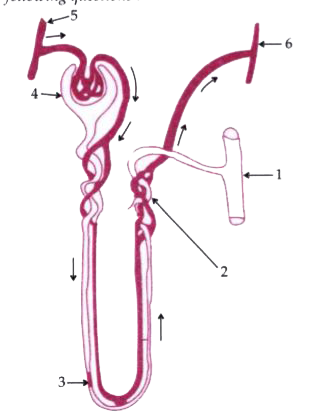
Name the blood vessel which contains the least amount of urea in this diagram.
View SolutionThe given diagram represents a nephron and its blood supply. Study the diagram and answer the question :
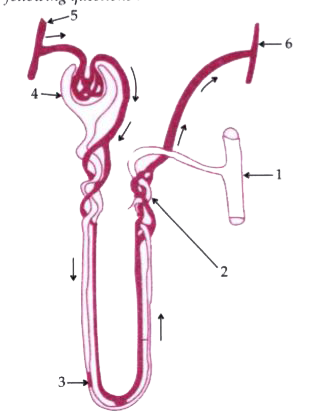
Name the part of the nephron which lies in the renal medulla.
View SolutionThe given diagram represents a nephron and its blood supply. Study the diagram and answer the question :

Name the part of the nephron which lies in the renal medulla.
View SolutionExplain any two functions of cerebrospinal fluid in humans.
View SolutionState the main function of the following :
Ear ossicles
View SolutionGive the exact location and one function of Pinna.
View SolutionState the main function of the following:
Cuticle
View SolutionGive the exact location and one function of the following:
Thylakoids
View SolutionThe diagram given below is an external view of the human brain. Study the same and answer the questions that follow :
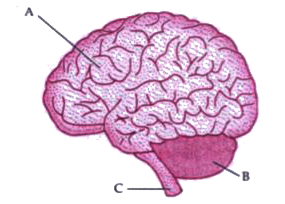
Name the parts labelled A, B and C in the diagram.
View SolutionThe diagram shows a section of the human brain. Answer the question which follow:
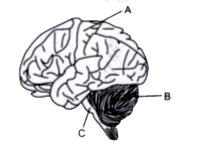
Give the main function of each of the parts A, B and C.
View SolutionThe diagram shows a section of the human brain. Answer the question which follow:
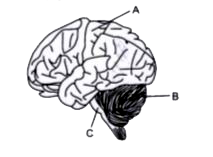
Name the three protective membranes covering the brain.
View SolutionThe diagram shows a section of the human brain. Answer the question which follow:
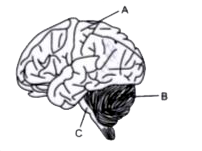
Name the basic unit of the brain.
View SolutionThe diagram given below is an external view of the human brain. Study the same and answer the questions that follow :

Mention the collective term for the membranes covering the brain.
View SolutionGive the biological/technical terms for the following:
The quick actions which are involumtary and controlled by the spinal cord.
View SolutionName the Eye defect in which cornea becomes uneven.
View SolutionGive the biological/technical terms for the following:
The stage of cell division in which the nuclear membrane disappears and the chromosomes become short and thick.
View SolutionGive technical term to the following:
The inflammation of meninges.
View SolutionThe repeating components of each DNA strand lengthwise.
View SolutionGive the biological/technical terms for the following:
The site of photosynthesis in a plant cell.
View SolutionGive the biological technical term for the following:
Process of conversion of several molecules of glucose to one molecule of starch.
View SolutionName the Photosensitive pigment present in the cone cell of retina.
View SolutionName the Fluid present in the anterior part of the eye in front of the eye lens.
View SolutionGive the biological/technical terms for the following:
The defect of vision in which some parts of the objects are seen in focus while the others are blurred.
View Solution
SECTION - II questions and complete solutions for chapter SELF ASSESSMENT PAPER 5 of EVERGREEN BIOLOGY (ENGLISH) of Class 10